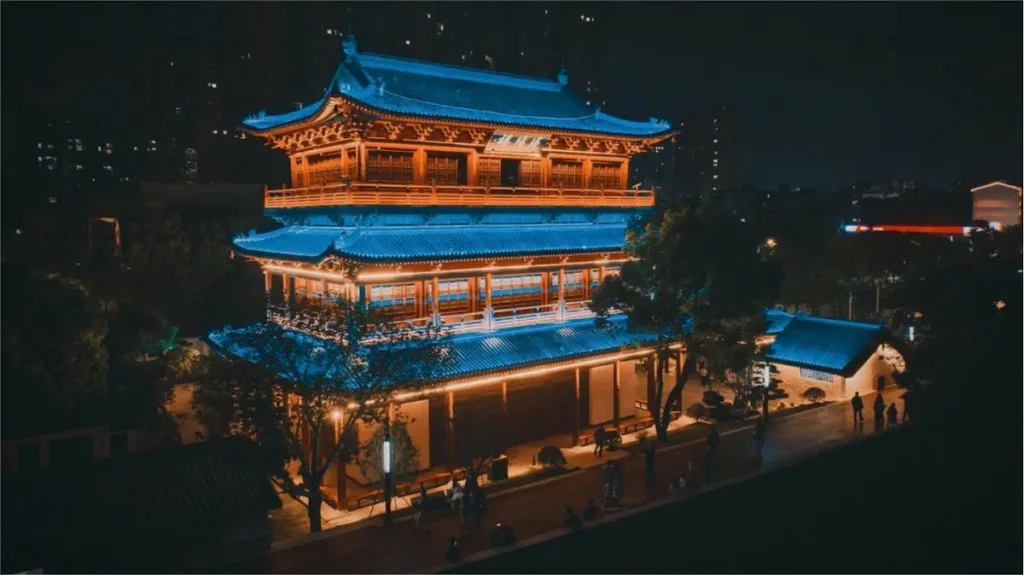Shizhong Mountain (石钟山) is located in Jiujiang City, Jiangxi Province, with an elevation of 61.8 meters and a relative height of approximately 40 meters, covering an area of 0.2 square kilometers. The name “Shizhong Mountain,” which means “Stone Bell Mountain,” originates from the resonant sounds produced by the interaction of water and rocks on the mountain, resembling the ringing of a bell.
In fact, Shizhong Mountain is not a single mountain but consists of two separate peaks located less than one kilometer apart. The southern peak, adjacent to Poyang Lake, is known as Upper Shizhong Mountain, while the northern peak, near the Yangtze River, is called Lower Shizhong Mountain. Together, they are referred to as the “Twin Bell Mountains.”
The twin peaks are strategically situated, offering a commanding view of both the Yangtze River and Poyang Lake. Their steep and rugged terrain has historically made them a crucial military stronghold, often referred to as the “Key to the River and Lake.” The natural fortification provided by these mountains has made them significant in historical military defense.
Table of Contents
- Basic Information
- Location and Transportation
- Highlights of Shizhong Mountain
- Vlog about Shizhong Mountain
- Other Attractions in Jiujiang City
Basic Information
| Estimated Length of Tour | 1 – 2 hours |
| Ticket Price | 72 RMB |
| Opening Hours | 8.00 – 17.30 |
| Telephone Number | 0086-0792-6332816 |
Location and Transportation
Shizhong Mountain is located in the old town of Luokou County, Jiujiang City, Jiangxi Province, where the Yangtze River and Poyang Lake converge. To get there, you can choose one of the following ways:
- From Jiujiang Long-Distance Bus Station, take a bus to Luokou County (10 RMB per person). After arriving, you can take a local bus to Shizhong Mountain.
- Alternatively, you can take a boat from Jiujiang City to Shuangzhong Town in Luokou County (20 RMB per person), and then climb Shizhong Mountain.
Highlights of Shizhong Mountain
Two Colors of the River and Lake

The “Two Colors of the River and Lake” is located near Shizhong Mountain in Hukou County, Jiujiang City, Jiangxi Province, at the confluence of the Yangtze River, China’s largest river, and Poyang Lake, the country’s largest freshwater lake. At this point, the water from the Yangtze River appears brownish-yellow, while the water from Poyang Lake is a distinct greenish-blue. The meeting of these two waters creates a clear boundary between the two, presenting a remarkable natural phenomenon.
From Shizhong Mountain, one can observe a distinct dividing line between the two bodies of water, which stretches for over 50 kilometers. This striking visual contrast attracts numerous visitors from across the country each year, who come to witness this extraordinary natural spectacle.
Zhao Zhong Temple

Zhao Zhong Temple is situated at the summit of Shizhong Mountain, built in the eighth year of the Xianfeng reign (1858) during the Qing Dynasty. The construction was commissioned by officials including Peng Yulin in response to an imperial edict. This temple is the main structure of Shizhong Mountain and is divided into a front and rear hall, offering a broad view of the surrounding rivers and lakes.
The temple is historically significant, with inscriptions and calligraphy by notable figures such as Zeng Guofan and Peng Yulin. The front of the temple features a spacious square, and ancient camphor trees on either side were personally planted by Peng Yulin and others.
Inside the temple, there is a newly created performance of ancient bell music. The bells used for this performance are replicas based on those found in the tomb of Marquis Yi of Zeng in Hubei Province.
Bao Ci Zen Temple

Bao Ci Zen Temple is located to the west of Zhao Zhong Temple on Shizhong Mountain. The complex includes monk quarters, a stage, the Mahavira Hall, an island, and both front and rear courtyards. Originally established in the eighth year of the Xianfeng reign (1858) during the Qing Dynasty, it was created by Peng Yulin as a place to show gratitude by inviting monks to chant and worship.
The Zen Temple underwent reconstruction in the twenty-ninth year of the Guangxu reign (1903). The original Mahavira Hall, which housed Buddhist statues and the island, was destroyed over time. In 1980, the complex was restored, and new statues of Guanyin (the Goddess of Mercy) and other deities were installed in the hall and on the Penglai Island behind it.





